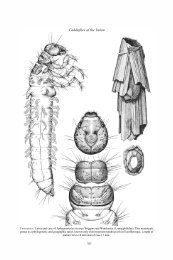(Ephemeroptera) of the Yukon - Department of Biological Sciences
(Ephemeroptera) of the Yukon - Department of Biological Sciences
(Ephemeroptera) of the Yukon - Department of Biological Sciences
Create successful ePaper yourself
Turn your PDF publications into a flip-book with our unique Google optimized e-Paper software.
Mayflies (<strong>Ephemeroptera</strong>)<br />
<strong>of</strong> <strong>the</strong> <strong>Yukon</strong><br />
P.P. HARPER and FRANÇOISE HARPER<br />
Département de sciences biologiques<br />
Université de Montréal, C.P. 6128, succ. “Centre-ville”<br />
Montréal, Québec, Canada H3C 3J7<br />
Abstract. Thirty taxa <strong>of</strong> mayflies are reported from <strong>the</strong> <strong>Yukon</strong> Territory. Four zoogeographical elements are<br />
recognized: 1) widespread Cordilleran and western coastal species, <strong>the</strong> largest group <strong>of</strong> species: Acentrella<br />
insignificans, Caenis youngi, Callibaetis ferrugineus hageni, Cinygmula spp., Drunella spp., Epeorus longimanus,<br />
Rhithrogena futilis, Siphlonurus occidentalis, and S. phyllis; 2) five Holarctic species: Baetis bicaudatus, B. bundyae,<br />
Ephemerella mucronata, Metretopus borealis, and Siphlonurus alternatus; 3) four species <strong>of</strong> transcontinental<br />
distribution: Baetis tricaudatus, Leptophlebia nebulosa, Paraleptophlebia debilis and Procloeon ingens, and 4) <strong>the</strong><br />
westernmost extension <strong>of</strong> <strong>the</strong> nor<strong>the</strong>astern Nearctic fauna: Heptagenia pulla and Siphloplecton prob. interlineatum.<br />
There is no endemic element. This fauna is very similar in diversity and composition to that <strong>of</strong> Alaska, but much<br />
poorer than that <strong>of</strong> <strong>the</strong> adjacent Mackenzie Valley in <strong>the</strong> Northwest Territories. It appears to be composed largely<br />
<strong>of</strong> <strong>the</strong> hardiest species <strong>of</strong> <strong>the</strong> western boreal fauna, with some eastern elements, but with few truly arctic components.<br />
Such a depauperate fauna may be due to particularly harsh climatic and ecological conditions and/or zoogeographical<br />
barriers, but it is not possible at <strong>the</strong> present time to rule out insufficient collecting as an important factor.<br />
Résumé. Les éphéméroptères (<strong>Ephemeroptera</strong>) du <strong>Yukon</strong>. Sur le territoire du <strong>Yukon</strong>, nous avons inventorié 30<br />
taxons d’éphéméroptères, parmi lesquels nous reconnaissons quatre éléments zoogéographiques: 1) des espèces<br />
néarctiques occidentales à répartition géographique étendue qui forment le groupe principal d’espèces: Acentrella<br />
insignificans, Caenis youngi, Callibaetis ferrugineus hageni, Cinygmula spp., Drunella spp., Epeorus longimanus,<br />
Rhithrogena futilis, Siphlonurus occidentalis et S. phyllis; 2) cinq espèces holarctiques: Baetis bicaudatus,<br />
B. bundyae, Ephemerella mucronata, Metretopus borealis et Siphlonurus alternatus; 3) quatre espèces à répartition<br />
transcontinentale: Baetis tricaudatus, Leptophlebia nebulosa, Paraleptophlebia debilis, et Procloeon ingens, et<br />
finalement 4) de rares espèces à répartition surtout orientale qui atteignent au <strong>Yukon</strong> leur extension maximale vers<br />
l’ouest: Heptagenia pulla et Siphloplecton prob. interlineatum. Il n’y a pas d’élément endémique. Cette faune est<br />
très semblable en composition et en diversité à celle de l’Alaska, mais elle est beaucoup moins riche que celle de<br />
la région adjacente de la vallée du Mackenzie, dans les Territoires du Nord-Ouest. Elle paraît se composer<br />
principalement des espèces les plus robustes de la faune boréale occidentale avec l’addition de quelques éléments<br />
d’origine orientale et peu d’éléments vraiment arctiques. Cette faune appauvrie pourrait s’expliquer par les<br />
conditions climatiques et écologiques particulièrement rigoureuses qui forment des barrières zoogéographiques,<br />
mais il est aussi possible qu’un inventaire plus systématique révèle une faune beaucoup plus riche qu’il n’apparaît<br />
actuellement.<br />
Introduction<br />
There has been only one systematic study <strong>of</strong> mayflies (<strong>Ephemeroptera</strong>) in <strong>the</strong> <strong>Yukon</strong><br />
Territory by Cobb et al. (1995) in Kluane National Park. There are also 2 series <strong>of</strong> collections<br />
<strong>of</strong> nymphs, one from <strong>the</strong> Porcupine and Mackenzie River drainages as part <strong>of</strong> pre-impact<br />
studies related to proposed pipeline and highway developments (Brunskill et al. 1973; Wiens<br />
et al. 1975), and <strong>the</strong> o<strong>the</strong>r assembled for a study <strong>of</strong> classification <strong>of</strong> northwestern streams<br />
and rivers (Corkum and Ciborowski 1988; Corkum 1989). A few rare o<strong>the</strong>r records are<br />
scattered through <strong>the</strong> literature (e.g. Harper and Harper 1981). Thus, <strong>the</strong> opportunity to study<br />
even <strong>the</strong> limited collections ga<strong>the</strong>red during <strong>the</strong> “Insect Fauna <strong>of</strong> <strong>the</strong> <strong>Yukon</strong> Project” was<br />
most welcome.<br />
pp. 151 – 167 in H.V. Danks and J.A. Downes (Eds.), Insects <strong>of</strong> <strong>the</strong> <strong>Yukon</strong>. <strong>Biological</strong> Survey <strong>of</strong> Canada (Terrestrial Arthropods),<br />
Ottawa. 1034 pp. © 1997
















